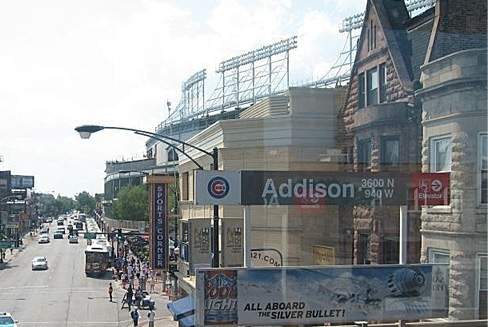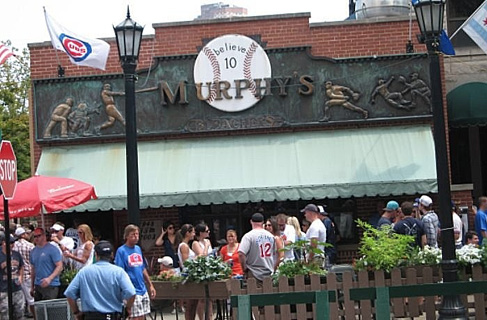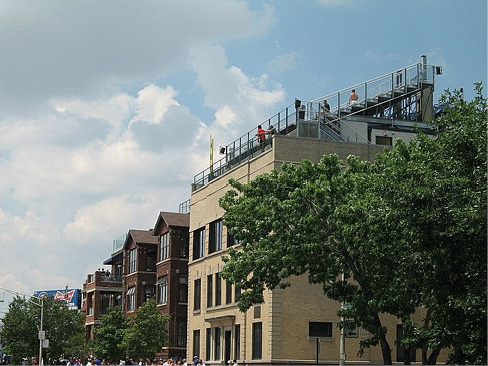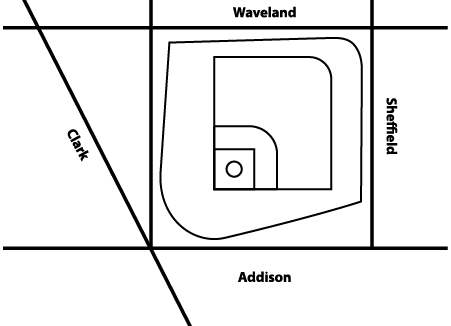The Wrigleyville Neighborhood
“[T]oo many parks aren’t situated where they should be – and that is, preferably, not just in a city but in a neighborhood.” — Travis Sawchik1
Sawchik is not alone in praising Wrigleyville. Kevin Kaduk titled his diary of attending the full 2005 Cubs home slate, Wrigleyworld: A Season in Baseball’s Best Neighborhood.2 Brad Null and Dave Kaval, who toured all major-league parks in 1998, wrote about seeking the nightlife wherever they went, but only in Wrigleyville finding “daylife.”3
Part of Wrigleyville’s appeal is the ballpark’s longevity and sense of history. Except for Wrigley and Boston’s Fenway Park,4 all neighborhood ballparks from the early and mid-twentieth century are gone (e.g., Brooklyn’s Ebbets Field, DC’s Griffith Stadium, and Philadelphia’s Shibe Park), and most current ballparks are either downtown or someplace with vast parking lots. Wrigleyville is such a bona fide residential neighborhood that Cubs President Theo Epstein and several players live there. Epstein described its advantages: “For a night game after batting practice, it’s like a dead time usually for an hour or an hour and a half. … I like to walk home and have dinner with my kids, do the bedtime thing and make it back for first pitch. … I don’t know where else you could do that.”5
With its nightlife, daylife, and convenient living, Wrigleyville is a popular area to many, but it also has its detractors. Through examination of the area and its inhabitants, social atmosphere, and historical evolution, readers not already intimately familiar with Wrigleyville may get a better idea of its attractions and less pleasant aspects.
Basic Information
Location: As depicted below, Wrigley Field is surrounded by Clark Street, Addison Street, Sheffield Avenue, and Waveland Avenue, on Chicago’s north side. It sits roughly four miles north of the downtown Loop and a mile west of the Lake Michigan shoreline.
Wrigleyville is not one of Chicago’s 77 official “community areas,” but falls instead within the Lake View jurisdiction. Sources differ on Wrigleyville’s precise boundaries, but most define them as extending three to five blocks beyond the ballpark on all sides. Expanding the perimeter, Kaduk richly describes Wrigleyville’s location: “gritty Irving Park to the north, artsy Belmont to the south, yuppie Southport to the west, and gay Halsted to the east.”6
Demographics: Trendy and close to entertainment, the lake, and public transportation, Wrigleyville living is naturally expensive. The real-estate website Trulia found Wrigleyville housing to cost 2.2 times as much as the Chicago average, tying for the major leagues’ fourth highest ratio.7 My informal survey of Wrigley-area apartment ads discovered rental prices approaching $2,000 a month and costs of $400,000 to $500,000 to own.
Looking at Census tracts near Wrigley, the area’s racial-ethnic composition is roughly 90 percent white; among other groups, Hispanic residents are slightly more numerous than Asian and African-American residents.8 Scott Simon describes neighborhoods near Wrigley as “some of the most truly diverse in America.”9 This characterization is especially true of neighborhoods extending from Wrigley to Chicago’s northern boundary.10
Nearly one-third of Wrigleyville residents are in their 20s.11 Its sports, music, and drinking venues attract young people – Chris Erskine deems the area a “post-collegiate playground”12 – but high rents would seem unaffordable for young workers. Perhaps some double- or triple-up with roommates, but many young adults in Wrigleyville are college-educated, with reasonably high incomes for their age.13 Urban-planning expert Richard Florida highlights the growing economic role of artists, architects, technology workers, writers, and the like, and how they are attracted to places known for tolerance and amenities.14 These workers, known as the “creative class,” are indeed highly common in Wrigleyville.15

Social Atmosphere: Pregame excitement builds as fans converge on Wrigley from all directions. Elevated train lines (the “El”) deliver fans a block from the ballpark (see photo above). Parking is very limited, so drivers have to explore residential areas (sometimes several blocks from Wrigley) and pay to park in someone’s garage. Souvenir stands, bars, restaurants, and apartment buildings with rooftop bleachers create a buzz of activity.

Drinking and Revelry: One stadium-discussion site claims, “No other ballpark in the country can compete with the sports bars that you will find outside of Wrigley Field.”16 Kaduk notes that a quarter-mile stretch of Clark Street by Wrigley contains 21 bars.17 The bar Murphy’s Bleachers (shown below) is behind center field. Kaduk coined the term “Disneyland bars” for six establishments – Sluggers, the Cubby Bear, Hi-Tops,18 Murphy’s, Sports Corner (visible in the El-station photo), and Casey Moran’s – whose popularity has made them tourist attractions.
Not surprisingly, Wrigleyville (Lakeview, technically) has the highest rate of binge-drinking in Chicago and one of the highest levels nationally.19 Statistics on public-urination infractions show the area near the Wrigley El station to lead the city in this behavior.20 Even on an El ride to the game, some passengers can be loud and obnoxious, having apparently engaged in pregame drinking.
Ballpark-area bars have also been criticized from a beverage-connoisseur perspective. One Wicker Park barkeep, specializing in craft and international beers, announced, “We wanted to do something with integrity, and not just open a place with a bunch of beer and TVs. … We’re digging in our heels and saying we’re not allowing our neighborhood to become another Wrigleyville.”21
Rooftops: Bleacher seating atop apartment buildings, looking into the ballpark, is a phenomenon closely associated with Wrigley Field. However, similar viewing is, or has been, available in other cities.22 Whereas yesterday’s apartment-dwellers could go upstairs during a game at their leisure, today’s Wrigley rooftops involve tickets, food and beverage service, and other stadium-type amenities. In recent decades “many of the apartments were cleared out, renovated, and turned into full-blown business ventures.”23 Nearly all the buildings have an inside floor like a major-league club level,24 whereas some are total shells with no apartments at all.25 One might pay around $100 to sit on a rooftop with an all-you-can-eat (and drink) buffet of ballpark-type fare.26 The Cubs and rooftop owners have disputed whether the latter is stealing the former’s product. Rooftop owners have paid the team a share of rooftop profits in settlements,27 but the issue seems increasingly moot, as the Cubs’ owners, the Ricketts family, have been purchasing the buildings.28
Music Scene: Wrigleyville is also a live-music hub. The Cubby Bear does double duty as a music venue at night. Outside of sports bars, fans of pop-rock, heavy-metal, and the like can also go to small (roughly 1,000-seat) concert halls, including the Vic Theatre and Metro.29 Most bands are local, with occasional appearances by nationally and internationally known acts. Wrigley Field itself has also become quite a concert venue, hosting such major acts as Bruce Springsteen, Pearl Jam, and Paul McCartney in recent years.30
Ballpark Noise: Some sounds – such as the park’s organ music as one walks toward Wrigley – can enhance anticipation for the game. However, installation of a new Wrigley videoboard and sound system in 2015 took the volume to a new level. One resident, 12 blocks away, heard the national anthem so loudly he mistakenly blamed his neighbor’s television.31 There’s also a YouTube video claiming to pick up the crowd singing “Go Cubs Go” from a mile away!32
Past and Future
Wrigleyville has evolved over the past half-century from industrial – with the triangle between Clark Street and the ballpark containing large coal silos until 196133 – to eclectic and quirky.34 The latest construction projects suggest Wrigleyville’s next phase may be as a playground for the rich, which has alarmed many longtime observers.35
Simon sees Wrigleyville’s post-industrial transformation as presaging the 1988 debut of night games. In the 1970s, “A neighborhood of families who worked long hours in factories and warehouses began to become prime territory for youngish urban professionals … [who] liked the brio and dash of living near Wrigley, and cared less about quiet streets by 10:00 p.m.”36
The 1970s and ’80s were also a heyday for eclectic and quirky tastes in Wrigleyville. Rolling Stone magazine recalls nostalgically the establishments offering “all things counter culture, from punk and metal to goth,” to comic books, to items “from bullet belts to bongs.”37 Many of these establishments, sustained by inexpensive rents at the time, are now gone.
As Wrigleyville continued in its trendiness and, some argue, Cubs management sought to monetize more activities from fans’ ballpark visits to fund a more competitive team in the new century,38 a shift toward more upscale clients seemed to accelerate. Construction has occupied large chunks of Addison and Clark (as of mid-2017), with new establishments to include a Cubs office building, team store, “boutique” hotel,39 apartments, restaurants, and other commercial space.40 Fans of the displaced McDonald’s41 on Clark need not worry, however. The hotel being erected in its place will include a McDonald’s inside.42
What does the future hold for Wrigleyville? In this author’s view, the neighborhood’s eclectic aspects – the music, the arts, the counter-culture – probably won’t disappear anytime soon. However, as the immediate ballpark area becomes more upscale, many wild, weird, and wonderful aspects may be driven to the outskirts of Wrigleyville or even to other neighborhoods.
Chicago native ALAN REIFMAN is professor of human development and family studies at Texas Tech University and holds a Ph.D. from the University of Michigan. Within SABR, Alan’s interests include ballparks and their surrounding neighborhoods, and statistics. He has contributed to the SABR books Dome Sweet Dome: History and Highlights from 35 Years of the Houston Astrodome (2017) and Detroit Tigers 1984: What a Start! What a Finish! (2012).
Sources
All photos courtesy of Alan Reifman.
Notes
1 Sawchik covered the Pirates for the Pittsburgh Tribune-Review from 2013-2016 and also wrote the book Big Data Baseball (Flatiron Books, 2015). This quote is from FanGraphs, Sawchik’s new home. fangraphs.com/blogs/the-new-generation-of-ballparks-is-pushing-us-away/.
2 Kevin Kaduk, Wrigleyworld: A Season in Baseball’s Best Neighborhood (New York: Penguin Books, 2006).
3 Brad Null and Dave Kaval, The Summer That Saved Baseball (Nashville: Cumberland House, 2001), 262-270.
4 The Kenmore Square area near Fenway Park draws some comparisons to Wrigleyville. Cubs manager Joe Maddon offered this view on the two communities: “[Fenway] is wonderful inside, just like Wrigley is. The difference is the location itself. We’re in a neighborhood. When you drive up to the ballpark, there is no freeway [akin to the Massachusetts Turnpike] along the outfield there. There are some restaurants and bars, etc., around [Fenway], which is kind of cool. But Wrigley is just a big neighborhood ballpark, and I love it for all of that.” Paul Sullivan, “Tale of two (baseball-mad) cities – and of two ballparks,” Chicago Tribune, April 28, 2017. chicagotribune.com/sports/columnists/ct-cubs-red-sox-comparisons-sullivan-spt-0429-20170428-column.html.
5 Paul Sullivan, “A Cub next door? Players embrace Wrigleyville living,” Chicago Tribune, August 15, 2016. http://www.chicagotribune.com/sports/baseball/cubs/ct-cubs-living-in-wrigleyville-spt-0816-20160815-story.html
6 Kaduk, 35.
7 “America’s Most Expensive Baseball Stadium Neighborhoods,” Forbes, March 28, 2013. By cost per square foot, the area by San Francisco’s AT&T Park is the most expensive ballpark neighborhood ($653), but because housing is very expensive in the Bay Area generally, living near the Giants’ home was only 1.3 times as pricey as in San Francisco overall. https://forbes.com/sites/trulia/2013/03/28/americas-most-expensive-baseball-stadium-neighborhoods/#4b9838a44f50.
8 Census tracts near Wrigley Field and their racial-ethnic breakdowns are as follows: Census Tract 061200 (Whites 90.4%, Hispanics 6.2%, Blacks 1.5%, Asians 3.6%, others 4.4%); Census Tract 83200 (Whites 88.8%, Hispanics 7.5%, Blacks 2.2%, Asians 5.3%, others 3.6%); Census Tract 061000 (Whites 89.9%, Hispanics 6.4%, Blacks 1.8%, Asians 3.4%, others 4.9%); Census Tract 061100 (Whites 92.5%, Hispanics 4.8%, Blacks 1.3%, Asians 3.3%, others 2.8%). Obtained via usa.com.
9 Scott Simon, My Cubs: A Love Story (New York: Blue Rider Press, 2017), 132.
10 Emily Chow, Christopher Groskopf, Joe Germuska, Hal Dardick, and Brian Boyer, “Reshaping Chicago’s Political Map: Race, Ward-by-Ward,” Chicago Tribune, July 14, 2011. As of 2010, in all or parts of City Council Wards 40, 46, 48, 49, and 50 (north of Wrigley and near the Lake Michigan coast) no racial-ethnic group comprised more than 50% of the area population. This pattern reflects less numerical domination by any one group in a ward and, therefore, greater diversity. For example in Ward 49 (Rogers Park and West Ridge), Whites comprised 37% of residents, African-Americans 28%, and Hispanics 24%. media.apps.chicagotribune.com/ward-redistricting/index.html.
11 According to Town Charts, Wrigley’s “ZIP code 60613 has one of the largest proportions of people 20 to 29 year olds at 31.5% of the total and is ranked #3” among Chicago ZIP codes. towncharts.com/Illinois/Demographics/60613-Zipcode-IL-Demographics-data.html.
12 Chris Erskine, “My Guitar Gently Weeps for Chicago, John Prine, Sinful Sandwiches and the Old ’Hood Near Wrigley,” Los Angeles Times, August 19, 2017. latimes.com/home/la-hm-erskine-column-20170819-story.html
13 Kaduk.
14 Richard Florida and Charlotta Mellander, “‘There Goes the Neighbourhood:’ How and Why Bohemians, Artists and Gays Affect Regional Housing Values,” Martin Prosperity Institute, Rotman School of Management, University of Toronto, 2007. creativeclass.com/rfcgdb/articles/there%20goes%20the%20neighborhood.pdf.
15 Richard Florida, “Class-Divided Cities: Chicago Edition,” City Lab/Atlantic Monthly Group, February 4, 2013. The Census tract including Wrigley Field contains 45% creative-class, 50% service-industry, and 5% working-class employees; in Wrigleyville areas just beyond the ballpark, the creative class rises to 60% of workers. For comparison, Guaranteed Rate Field, home of the White Sox on Chicago’s South Side, has far more of its surrounding tracts dominated by service workers. citylab.com/equity/2013/02/class-divided-cities-chicago-edition/4306/.
16 Ballpark Chasers, “Wrigley Field.” ballparkchasers.com/notes/Wrigley_Field.
17 Kaduk.
18 Hi-Tops is no longer in operation. See: Sean Parnell, “Hi-Tops,” Chicago Bar Project. chibarproject.com/Memoriam/HiTops/Hi-Tops.htm.
19 Matt Lindner, “Lakeview Has the Highest Rate of Binge Drinking in Chicago,” Chicago Tribune, December 22, 2016. chicagotribune.com/lifestyles/ct-lake-view-binge-drinking-1221-20161221-story.html.
20 Mark Konkol and Tanveer Ali, “Wrigleyville Is Chicago’s Public Urination Capital, Data Shows,” The Block Club, August 24, 2015. dnainfo.com/chicago/20150824/wrigleyville/wrigleyville-is-chicagos-public-urination-capital-data-shows.
21 Peter Frost, “Restaurateurs: We Won’t Let Wicker Park Become Wrigleyville,” Crain’s Chicago Business, January 28, 2015. chicagobusiness.com/article/20150128/BLOGS09/150129797/restaurateurs-we-wont-let-wicker-park-become-wrigleyville.
22 Former ballparks with rooftop viewing included Shibe Park and Griffith Stadium. See: Ryan Swanson, “Ballparks We Miss: Shibe Park (1909–1970),” The National Pastime Museum. August 16, 2017. thenationalpastimemuseum.com/article/ballparks-we-miss-shibe-park-1909-1970; and “Parks of the Past: Griffith Stadium, Washington D.C.” (Reddit discussion topic). reddit.com/r/baseball/comments/1rhtfd/parks_of_the_past_griffith_stadium_washington_dc/. Regarding current ballparks, high-rise apartments and condominiums have been advertised in recent years with views into D.C.’s Nationals Park and San Diego’s Petco Park. See Benjamin Freed, “Residents of New Navy Yard Building Will Be Able to Watch Nationals Games From the Roof,” Washingtonian, April 7, 2016. washingtonian.com/2016/04/07/new-navy-yard-apartment-building-will-come-with-ultimate-perk-free-baseball/ ; JD Land, Preview of “Flrst” apartment building in Washington, DC. jdland.com/dc/f1rst.cfm ; and “Icon San Diego Condos with awesome views into the Padre’s (sic) Petco Park!” youtube.com/watch?v=gcshxwzxrCc.
23 Ryan Davis, “How I Learned That the Wrigley Rooftops Aren’t Evil,” Chicago Now/Cubs Insider, August 13, 2014. chicagonow.com/cubs-insider/2014/08/how-i-learned-that-the-wrigley-rooftops-arent-evil/.
24 See the slickly produced marketing website wrigleyrooftopsllc.com/ for extensive photographs of each building’s baseball-viewing amenities.
25 Barry Bearak, “Cubs’ Owners Are Rebuilding While Root, Root, Rooting,” New York Times, September 19, 2014. nytimes.com/2014/09/21/sports/baseball/as-cubs-slowly-rebuild-theres-shouting-from-the-rooftops.html.
26 Ibid.
27 Becky Yerak, “Wrigley Rooftops’ Quirky Past Preceded Big Business, Sour Relationship With Cubs,” Chicago Tribune, October 28, 2016. chicagotribune.com/business/ct-wrigley-rooftops-history-1028-biz-20161027-story.html.
28 Jay Koziarz, “Ricketts Family Now Controls Majority of Wrigley Field Rooftops,” Curbed Chicago, January 13, 2016. https://chicago.curbed.com/2016/1/13/10847008/ricketts-purchase-three-rooftops-for-majority-controll.
29 “The 15 Best Places With Live Music In Lakeview, Chicago,” Four Square, August 21, 2017. foursquare.com/top-places/lakeview-chicago/best-places-live-music.
30 Greg Kot, “Shows That Shook Wrigley All Night Long,” Chicago Tribune, April 1, 2014. chicagotribune.com/ct-ent-0402-wrigley-concerts-20140401-column.html.
31 Patrick M. O’Connell, “Residents Complain Wrigley Field Is Louder Than Previous Years,” Chicago Tribune, April 6, 2015. chicagotribune.com/news/local/breaking/ct-wrigley-field-noise-met-20150406-story.html.
32 “‘Go Cubs Go’ From a Mile Away” youtube.com/watch?v=3U8WaNbZ0PU.
33 Digital Research Library of Illinois History Journal, “Silos at Wrigley Field?” December 1, 2016. drloihjournal.blogspot.com/2016/12/wrigley-field-silos-at-wrigley-field.html.
34 For a highly detailed history of both Wrigley Field and its surrounding neighborhood, especially the first three decades, see Stuart Shea, Wrigley Field: The Long Life and Contentious Times of the Friendly Confines (Chicago: University of Chicago Press, 2014). Another book seemingly in this genre is Wrigleyville, by Peter Golenbock (New York: St. Martin’s/Griffin, 1999), but it concentrates primarily on the Cubs’ on-the-field history.
35 In his book A Nice Little Place on the North Side (New York: Crown Archetype, 2014), 175, George Will writes, “As [Wrigley Field] enters its second century, however, the residential neighborhood is, if not unhappy, certainly uneasy, and those who love the ballpark worry that its unassuming character might perish.”
36 towncharts.com/Illinois/Demographics/60613-Zipcode-IL-Demographics-data.html.
37 Jason Diamond, “Chicago Cubs and the Last Days of Old, Weird Wrigleyville,” Rolling Stone, September 27, 2016. Embedded in the online Rolling Stone article is a great YouTube video from 1984 of the Cubby Bear’s dual existence: sports bar by day to punk-rock mosh-pit by night. rollingstone.com/sports/chicago-cubs-wrigleyville-neighborhood-experiences-change-w441949.
38 Stuart Shea (Ibid. Note 36) discussed the Cubs’ recent strategies to increase revenues and fund a better team at the SABR 45 conference’s Ballparks Committee meeting, in Chicago (2015).
39 The phrase “boutique hotel” appears on the hotel’s website (hotelzachary.com/), as part of its effort to attract customers.
40 The Chicago Sun-Times published an excellent overview of all the construction projects surrounding Wrigley Field, including maps, photographs, and artist renderings. Eric White, “The New Wrigleyville: 4 Big Projects Going Up Around Cubs’ Home,” Chicago Sun-Times, April 12, 2017. chicago.suntimes.com/sports/the-new-wrigleyville-4-big-projects-going-up-around-cubs-home/.
41 Patrick M. O’Connell, “Cubs Fans Already Missing Torn-Down McDonald’s Near Wrigley,” Chicago Tribune, April 5, 2016. chicagotribune.com/news/ct-wrigley-field-mcdonalds-met-20160405-story.html.
42 “As the Cubs Enter the Playoffs, Hotel Zachary Preps for Its Inaugural Season,” Building Up Chicago, September 27, 2016. buildingupchicago.com/2016/09/27/as-the-cubs-enter-the-playoffs-hotel-zachary-preps-for-its-inaugural-season/.




